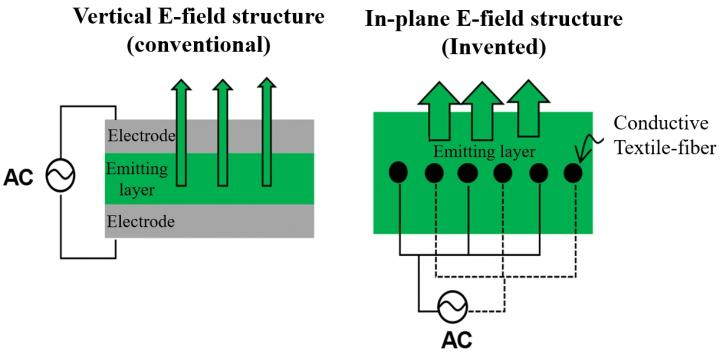Apr 1 2020
A new framework for luminescence technology has been developed by researchers in Dr Soon Moon Jeong’s group in the Division of Energy Technology at the Daegu Gyeongbuk Institute of Science and Technology (DGIST).
 The structure of the existing light-emitting device (left) and a new device with electrodes inside the light-emitting layer (right). Image Credit: DGIST.
The structure of the existing light-emitting device (left) and a new device with electrodes inside the light-emitting layer (right). Image Credit: DGIST.
This will pave the way for producing light-emitting elements that solve the drawbacks of prevalent techniques, predicted to considerably enhance the efficiency of light-emitting elements used in different applications like banners and billboards.
Light-emitting devices require electrodes to transfer energy to the light-emitting layer. The “flat electrode” used in this study is an electrode containing a coplanar structure around the light-emitting layer. This has a drawback that the electrode blocks light emitted from the light-emitting layer. The decline in the flexibility of the electrodes also hindered the manufacture of a flexible light-emitting device that constantly emits light.
Dr Jeong’s team solved this by cross-inserting a new kind of electrode made of fibers into the light-emitting layer, in contrast to present-day light-emitting devices. Thus, they could create new light-emitting technology by using an in-plane electric field produced in parallel to the light-emitting layer.
The light-emitting device created through this method enhanced the efficiency to a large extent by emitting light more stably and flexibly compared to the existing light-emitting devices.
Dr Jeong’s group used a new luminescent film using zinc sulfide (ZnS) and polydimethylsiloxane (PDMS) on the luminescent layer. The in-plane electric field was also used. Meanwhile, they also made the mechanoluminescence (ML) possible, which produces light by using mechanical force and electroluminescence (EL) that generates light by operating the electric field.
Although this new technology was not feasible in traditional light-emitting devices, it could maintain efficient and constant light intensity in different environments.
The light-emitting device thus built offered vital clues to solve different limitations of the prevalent light-emitting device. Initially, the structure of the light-emitting device built by Dr Jeong’s group overcame the drawbacks of the existing light-emitting device where electrodes are inserted into the light-emitting layer to block light.
Thus, at the same time, the researchers also overcame the limitation that thick electrodes necessitated a further increase in the light intensity of the light-emitting device instead of blocking the light from the light-emitting layer between them.
We want to change the paradigm of related industries in the future through the development of devices that emit light constantly, despite any changes of forms. This is definitely possible if we improve the light emitting device further, and it is expected to be used in various forms of light emitting textile and wearable devices.
Dr Soon Moon Jeong, Division of Energy Technology, Daegu Gyeongbuk Institute of Science and Technology
The results of this study were published in the most recent issue of Materials Today, a world-renowned international journal in materials engineering. The study was performed with the support of DGIST and the mid-carrier researcher support project carried out by the Ministry of Science and ICT.